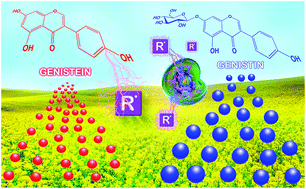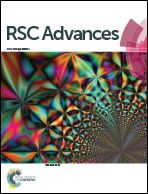(Bio)-synthesis of Au NPs from soy isoflavone extracts as a novel assessment tool of their antioxidant capacity
Abstract
In this work, (bio)-synthesis of Au NPs using selected isoflavone classes has been studied. To this end, relevant aglycones (genistein and daidzein) and their glycosides (genistin and daidzin) as well as complex soy-extracts with a well-documented composition have been explored. A sigmoidal curve described the (bio)-synthesis of Au NPs which was used to evaluate the antioxidant activity and to carry out a reliable comparison of the antioxidant activity of soy isoflavone extracts towards the assessment of two relevant parameters: the concentration value at which the absorption reaches its half-value; X50c, and Au NPs production, KAuNPs. Although both isoflavone classes generated Au NPs; however, genistein exhibited a marked bio-synthesis efficiency with the lowest X50c = 70 mg L−1 and the highest KAuNPs = 0.200 mg−1 L values. In addition, complex soy isoflavone extracts with high total isoflavone aglycone content exhibited higher bio-synthesis efficiency than those found with high total glycoside content. Interestingly, excellent correlations between X50c and total phenolics (TP) (from Folin–Ciocalteu (FC) assay as truly antioxidant capacity assay) (r = 0.93, p-value < 0.05) and KAuNPs and TP (r = 0.85, p-value < 0.10) were also obtained confirming the superior antioxidant activity of aglycones isoflavone class. UV-vis and TEM characterization revealed that both genistein standard and soy isoflavone extracts with a high aglycone content produced red colloidal solutions of Au NPs. In contrast, glycoside standards as well as soy isoflavone extracts with a high glycoside content, generated blue colloidal solutions. The overall results obtained from our studies allowed us to hypothesize that the high antioxidant activity found in soy isoflavone extracts could have a significant direct relationship with the (bio)-synthesis of Au NPs with a small diameter and with the strong red colour exhibited at 540 nm. All of this opens new avenues in a very important research field such as the bio-synthesis of Au NPs as a novel tool for evaluation of antioxidant activity of target extracts.


 Please wait while we load your content...
Please wait while we load your content...